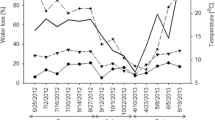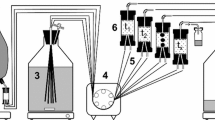Abstract
In situ microcosms were successfully used to study the degradation of a range of organic compounds in two pristine aquifers, one aerobic (Vejen) and one anaerobic (Villa Farm). Degradation and sorption behavior in the laboratory column microcosms packed with Villa Farm sediment was very similar to that in the in situ microcosms. However, when the columns were packed with quartz and equilibrated with aerated Villa Farm groundwater, behavior mirrored that at Vejen, indicating that oxygen rather than sediment or groundwater composition was the critical parameter. The aromatic and polyaromatic compounds (benzene, toluene,o-xylene, naphthalene) degraded under aerobic conditions only. The organochlorine compounds (trichloroethylene, tetrachloroethylene, 1,1,1-trichloroethane, 1,4-dichlorobenzene and 1,2-dichlorobenzene) showed little or no sign of degradation either aerobically or anaerobically. Interpretation of the data was complicated by strong sorption to the Villa Farm sediment but tetrachloromethane, nitrobenzene, ando-nitrophenol appeared to degrade under anaerobic conditions only. Phenol degraded rapidly under both sets of conditions.
Similar content being viewed by others
References
Acton DW and Barker JF (1992) In-situ biodegradation potential of aromatic hydrocarbons in anaerobic groundwaters. J Contam Hydrol 9:325–352
Alvarez PJ and Vogel TM (1991) Substrate interactions of benzene, toluene, and para-xylene during microbial degradation by pure cultures and mixed culture aquifer slurries. Appl Environ Microbiol 57:2981–2985
Baedecker MJ, Cozzarelli IM, Eganhouse RP, Siegel DI, and Bennett PC (1993) Crude oil in a shallow sand and gravel aquifer-II. Biogeochemical reactions and mass balance modeling in anoxic groundwater. Appl Geochem 8:551–567
Barbaro JR, Barker JF, Lemon LA, and Mayfield CI (1992) Biotransformation of BTEX under anaerobic, denitrifying conditions: field and laboratory observations. J Contam Hydrol 11:245–272
Beller HR, Grbić-Galić D, and Reinhard M (1992) Microbial degradation of toluene under sulphate-reducing conditions and the influence of iron on the process. Appl Environ Microbiol 58(3):786–793
Berry DF, Francis AJ, and Bollag JM (1987) Microbial metabolism of homocyclic aromatic compounds under anaerobic conditions. Microbiol Rev 51(l):43–59
Bjerg PL and Christensen TH (1992) Spatial and temporal small scale variation in ground water quality of a shallow sandy aquifer. J Hydrol 138:133–149
Bjerg PL, Hinsby K, Christensen TH, and Gravesen P (1992) Spatial variability of hydraulic conductivity of an unconfined sandy aquifer determined by a mini slug test. J Hydrol 136:107–122
Bouwer J and McCarty P (1983a) Transformations of 1- and 2-carbon halogenated aliphatic organic compounds under methanogenic conditions. Appl Environ Microbiol 45(4):1286–1294
Bouwer J and McCarty P (1983b) Transformations of halogenated organic compounds under denitrification conditions. Appl Environ Microbiol 45:1295–1299
Brusseau ML (1992) Non-equilibrium sorption of organic chemicals: the impact of porewater velocity. J Contam Hydrol 9:352–308
Brusseau ML, Larsen T, and Christensen TH (1991) Rate-limited sorption and nonequilibrium transport of organic chemicals in low organic carbon aquifer materials. Water Resour Res 27:1137–1145
Christensen TH (1992) Attenuation of leachate pollutants in groundwater. In: Christensen TH, Cossu R, and Stegman R (Eds), Landfilling of waste: leachate. Amsterdam: Elsevier Applied Science, pp 441–483.
Christensen TH, Kjeldsen P, Lynkilde J, and Tjell JC (1989) Behaviour of leachate pollutants in groundwater. In: Christensen TH, Cossu R, and Stegmann R (Eds), Sanitary landfilling: process technology and environmental impact. London: Academic Press, pp 465–481
Collins VG (1963) The distribution of bacteria in freshwater. Proc Water Treat Exam 12:1036–1042
Erhardt HM and Rehm HJ (1985) Phenol degradation by microorganisms adsorbed on activated carbon. Appl Microbiol Biotechnol 21:32–36
Evans PJ, Mang DT, and Young LY (1991) Degradation of toluene and m-xylene and transformation of o-xylene by denitrifying enrichment cultures. Appl Environ Microbiol 57(2):450–454
Gibson DT and Subramanian VS (1984) Microbial degradation of aromatic hydrocarbons. In: Gibson DT (Ed), Microbial degradation of organic hydrocarbons. New York: Marcel Dekker, pp 181–252
Gillham RW, Robin MJL, and Ptacek CJ (1990a) A device for in situ determination of geochemical transport parameters. 1. Retardation. Groundwater 28:666–672
Gillham R, Starr RC, and Miler DJ (1990b) A device for in situ determination of geochemical transport parameters 2. Biochemical reactions. Groundwater 28:858–862
Godsy EM, Goerlitz DF and Grbić-Galić D (1992) Methanogenic biodegradation of creosote contaminants in natural and simulated ground-water ecosystems. Ground Water 30:232–242
Grbić-Galić D (1989) Microbial degradation of homocyclic and heterocyclic aromatic hydrocarbons under anaerobic conditions. J Ind Microbiol Suppl No. 4 30:237
Harrison I, Leader RU, Higgo JJW, and Tjell JC (1994) Determination of semi-volatile organic pollutants in small samples of groundwaters by liquid-liquid extraction and capillary gas chromatography. J Chromatogr A 688:181–188
Higgo JJW, Kinniburgh D, Smith B, and Tipping E (1993) Complexation of Co2+, Ni2+, UO 2+2 and Ca2+, by humic substances in groundwaters. Radiochim Acta 61:91–103
Holm PE, Nielsen PM, Albrechtsen H-J, and Christensen TH (1992) Importance of unattached bacteria and bacteria attached to sediment in determining potentials for degradation of xenobiotic organic contaminants in an aerobic aquifer. Appl Environ Microbiol 58:3020–3026
Hopkins GD, Semprini L, and McCarty PL (1993) Microcosm and in situ field studies of enhanced biotransformation of trichloroethylene by phenol-utilising microorganisms. Appl Environ Microbiol 59:2277–2285
Hutchins SR, Sewell GW, Kovacs DA, and Smith GA (1991) Biodegradation of aromatic hydrocarbons by aquifer microorganisms under denitrifying conditions. Environ Sci Technol 25:68–176
Jorgensen C and Aamand J (1991) Cometabolic transformation of o-xylene in groundwater.In: Berthelin J (Ed), Diversity of environmental biochemistry. Developments in geochemistry 6. Amsterdam: Elsevier
Knoll G and Winter J (1987) Anaerobic degradation of phenol in sewage sludge. Appl Microbiol Biotechnol 25:384–391
Kobayashi H and Rittmann BE (1982) Microbial removal of hazardous organic compounds at trace levels. Environ Sci Technol 16:170A-181A
Kuhn EP, Colberg PJ, Schnoor JL, Wanner O, and Zehnder AJB (1985) Microbial transformations of substituted benzenes during infiltration of river water to groundwater. Laboratory column studies. Environ Sci Technol 19:961–968
Kuhn EP, Zeyer P, and Schwarzenbach RP (1988) Anaerobic degradation of alkylated bezenes in denitrifying laboratory aquifer columns. Appl Environ Microbiol 54:490–496
Lanzarone NA and McCarty PL (1990) Column studies on methanotrophic degradation of trichloroethene and 1,2-dichloroethane. Ground Water 28:910–919
Larsen T, Christensen TH, Pfeffer FM, and Enfield C (1992a) Landfill leachate effects on sorption of organic micropollutants onto aquifer materials. J Contam Hydrol 9:307–324
Larsen T, Christensen TH, and Brusseau M (1992b) Predicting nonequilibrium transport of naphthalene through aquifer materials using batch-determined sorption parameters. Chemosphere 24:141–153
Limbert E and Betts B (1994) Biodegredation of trace levels of a complex organic pollutant mixture. Microbios 78:237–243
Lovley DR, Baedecker MJ, Cozzarelli DJ, Phillips EJP, and Siegel DI (1989) Oxidation of aromatic contamination coupled to microbial iron reduction. Nature 339:297–299
McNab WW and Narashima TN (1994) Degradation of chlorinated hydrocarbons and groundwater geochemistry: a field study. Environ Sci Technol 28:769–775
Howard P (1992) Log Kow: octanol water partition coefficient program. Syracuse, NY: Syracuse Research Corporation
Montgomery JH and Welkom LM (1990) Groundwater chemicals desk reference, 2nd ed. Chelsea, Michigan: Lewis Publishers
Nielsen PH and Christensen TH (1994a) Variability of biological degradation of aromatic hydrocarbons in an aerobic aquifer determined by laboratory batch experiments. J Contam Hydrol 15:305–320
Nielsen PH and Christensen TH (1994b) Variability of biological degradation of phenolic hydrocarbons in an aerobic aquifer determined by laboratory batch experiments. J Contam Hydrol 17:55–67
Senior E (1988) Multistage chemostat and other models for studying anoxic systems. In: Handbook of laboratory systems for microbial ecosystems, vol 1. pp 51–72 Editor JWT Wimpenny, CRC Press Inc, Boca Raton, Florida
Pedersen KBQ, Bjerg PL, and Christensen TH (1991) Correlation of nitrate profiles with groundwater and sediment characteristics in a shallow sandy aquifer. J Hydrol 124:263–277
Pritchard PH and Bourquin AW (1984) The use of microcosms for evaluation of interactions between pollutants and microorganisms. In: Marshall KC (Ed), Advances in microbial ecology, 7. New York: Plenum Press. pp 133–215
Rees JF and King JW (1981) The dynamics of anaerobic phenol degradation in Lower Greensand. J Chem Technol Biotechnol 31:306
Schwarzenbach RP, Giger W, Hoehn E, and Schneider JK (1983) Behaviour of organic compounds during infiltration of river water to groundwater. Environ Sci Technol 17:472–479
Siegrist H and McCarty PL (1987) Column methodologies for determining sorption and biotransformation potential for chlorinated aliphatic compounds in aquifers. J Contam Hydrol 2:31–50
Smolenski WJ and Suflita MS (1987) Biodegradation of cresol isomers in anoxic aquifers. Appl Environ Microbiol 53:710–716
Sumbler MG (1983) A new look at the Wolstonian glacial deposits of central England. Proc Geol Assoc 94:23–31
Verschueren K (1983) Handbook of environmental data on organic chemicals, 2nd ed. New York: Von Nostrand Reinhold
Vogel TM, Criddle CS, and McCarty PL (1987) Transformations of halogenated aliphatic compounds. Environ Sci Technol 21:722–736
Williams GM, Smith B, and Ross CAM (1991) The migration and degradation of waste organic compounds in groundwater. Adv Org Geochem 19(4–6):531–543
Wilson BH, Smith GB, and Rees JF (1986) Biotransformations of selected alkylbenzenes and halogenated aliphatic hydrocarbons in methanogenic aquifer materials: A microcosm study. Environ Sci Technol 20:997–1002
Wilson JT, Smith GB, Cochran JW, Barker JF, and Roberts PV (1987) Field evaluation of a simple microcosm simulating the behaviour of volatile organic compounds in subsurface materials. Water Resour Res 23:1547–1553
Young L and Rivera MD (1985) Methanogenic degradation of four phenolic compounds. Water Resour Res 19:1547–1553
Zeyer J, Kuhn EP, and Schwarzenbach RP (1986) Rapid microbial mineralization of toluene and 1,3-dimethylbenzene in absence of molecular oxygen. Appl Environ Microbiol 52:944–947
Author information
Authors and Affiliations
Rights and permissions
About this article
Cite this article
Higgo, J.J.W., Nielsen, P.H., Bannon, M.P. et al. Effect of geochemical conditions on fate of organic compounds in groundwater. Geo 27, 335–346 (1996). https://doi.org/10.1007/BF00766703
Received:
Accepted:
Issue Date:
DOI: https://doi.org/10.1007/BF00766703




